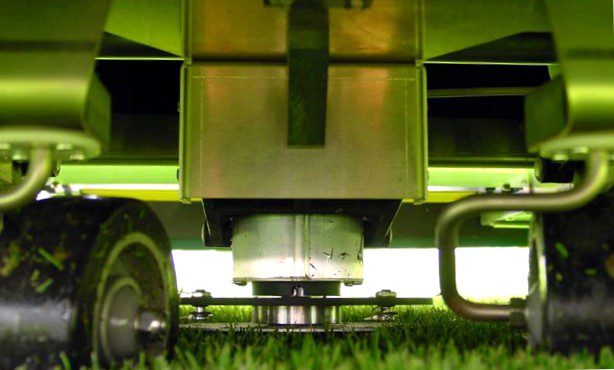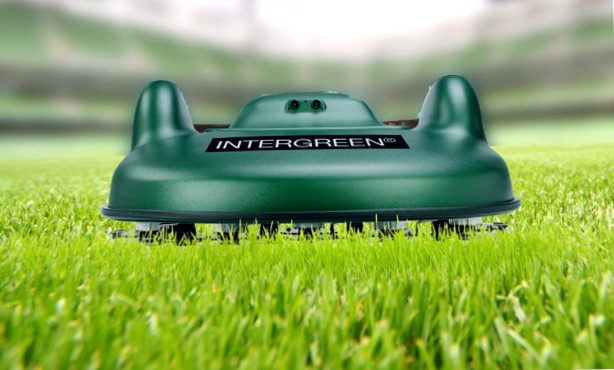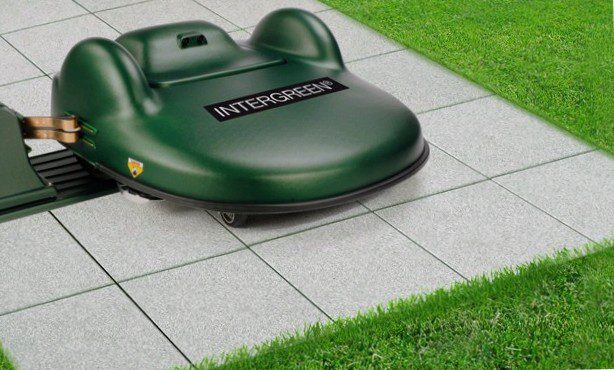Mowing robots – use on the sports lawn

Everyone knows it, everyone wants it, the absolute lifestyle product for the hobby gardener and the professional: the robotic mower as the automated, carefree lawnmower of the future. This is how it is increasingly suggested on the part of advertising at the moment. But is it really an alternative for professional use?
The INTERGREEN partner company Cordel has been relying on the use of robotic mowers for lawn care for several years now. Decision criteria are flexibility, mowing performance and mowing system. One use of robotic mowers, for example, took place on a natural grass pitch at the stadium in the municipality of Lohnberg, as well as on the associated secondary pitch, which is equipped with a hybrid grass system.
Decision criteria
It was already considered during the bidding process for the sports facilities that a robotic mowing system would be used. Decision criteria were:
– Cuttings remain on the sports field and thus serve as natural fertilizer; fertilizer quantities can be saved by this.
– Grasses to be subjected to less stress through controlled mowing sequences.
– Uniform mowing with permanent, even height of the sports turf.
– Segments and ancillary areas should also be mowed.
– Reduction of own or external personnel (both logistic and commercial) for the lawn care.
– Possibility of control during simultaneous operation of the sprinkler system.
– Operational safety and accident prevention.
– Environmental friendliness.
– Economic efficiency both in the area of the acquisition and in the operation.
General mode of operation
For the commissioning of a robotic mower system, the areas to be mowed are delimited by means of an underground signal cable (boundary wire, induction loop, signal cable). For this purpose, island solutions can be installed to take into account obstacles and sports facility equipment. In this confined field, the mowing robot moves randomly over. The robotic mower system can be selected from devices with a mowing capacity of 400 sqm to 20 sqm.000 sqm (daily), different cutting widths and various equipment to choose from. The robots are operated by means of the latest battery technology, which, depending on the model, are charged independently. Coordination together with the client for commissioning should be done in advance of installation. Here the exact location of the charging station (usually paved area), the location of the induction loop and various parameters of the robot programming are fixed. After laying the signal cable using a special tiller, creating a robot parking area outside the security areas of the sports facility and installing the charging station, the basic preliminary work for commissioning has already been completed.
Case study: Lohnberg municipality
The installation and commissioning of the robots took place in 2016. The two sports facilities are separated in terms of space and height, so it was not possible to operate a single mower for both fields.The installation of the robotic lawnmowers was carried out under different aspects. For the secondary pitch, a routing of the induction cable was selected so that a continuous mowing process could be carried out for the entire pitch. The decisive factor for this was the levelness of the adjacent side areas to the playing field boundary (curb), so that a tipping or a falling of the mower could be prevented. The possibility of the robot getting stuck could be ruled out. Several points had to be taken into account for the grass area around the stadium. The playing field with segments is bordered by drainage channels and curbs. In the area of the segments there is also a jumping pit and a shot-putting facility, which should be separated from the area to be mowed by an island solution. For this purpose, the induction loop was placed as a perimeter around the individual equipment items so that the mower does not touch these areas (the so-called island solution).
For both sports facilities, a coordinated programming of the mowing times with the sprinkler system was desired. Training times, playing times and event times should also be taken into account. In consultation with the responsible department heads, individual standing times were programmed into the robots and the groundsman was instructed in their use. Furthermore, special instruction was given in the operation and maintenance of the robots.
Comparison of robotic mower systems to tractor mowers
Economic and ecological factors are convincing more and more clubs and groundskeepers to buy or rent a robotic mower system. Compared to a mowing tractor, the savings potential in the amount of approx. 50 % of the purchasing and operating costs (calculated over a period of 4 years) and the independence of specialist personnel or. Third-party suppliers. In the ecological area, the much lower energy requirements, no CO2 emissions, no environmental impact from leaking liquids and the low-noise operation of a robotic mower stand out in particular. Minimizing the risk of accidents compared to ride-on mowers is also desirable and obvious for every user.
Since the robots move in a confined field and also have a GPS module, it is possible to locate their position at any time using a special computer program. Alarm messages are immediately forwarded to a previously specified cell phone in case of errors or movement outside a virtual fence (z.B. for attempted theft). Special insurances can cover possible risks such as vandalism and theft. Maintenance and repairs can also be ordered through special contracts with the supplier.
Mowing outside a confined field is not possible with the robotic mower, which limits it compared to a mowing tractor. However, it should be noted that the mowing of several, different areas (as often practiced in communities) significantly increases the likelihood of transmission of fungal diseases and weeds and thus generates costs for control.
Through years of experience in operation, maintenance and upkeep, Cordel has been confirmed in the use of robotic mowing systems. The use of such a system can be considered not only as an alternative, but as a future solution for mowing green areas, even for professionals, from all the given aspects. The market policy of robotic mower manufacturers for professional use, in contrast to previous years, allows a wider choice of systems offered. The mode of operation is comparable, as well as the costs. With a wide range of products, an individual selection based on personal interests (such as.B. Size of the mowing area, purchase price, entertainment, appearance, etc.) covered.




